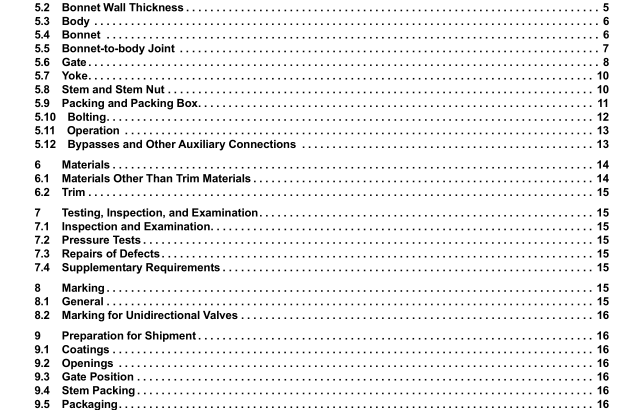API STD 603:2018 pdf free download.Corrosion-resistant, Bolted Bonnet Gate Valves—Flanged and Butt-welding Ends
5.3 Body
5.3.1 Flanged Ends
5.3.1.1 Body end flanges shall comply with the dimensional requirements of ASME B16.5. Unless otherwise specified, raised face end flanges shall be provided. The purchaser may specify a flange facing finish other than that specified in ASME B16.5.
5.3.1.2 Face-to-face dimensions shall be in accordance with ASME B16.10. Body end flanges and bonnet flanges shall be cast or forged integral with the body.
5.3.2 Butt-welding Ends
5.3.2.1 Butt-welding ends for valve sizes greater than DN 50 (NPS 2) shall conform to the requirements of ASME B16.25 and B16.34 for the bore specified for use without backing rings. Butt-welding ends for valves DN 50 (NPS 2) and smaller shall conform to the requirements of API 602. Conversion of a flanged end valve to a butt-welding valve for Class 300 and above may be permitted by agreement between the purchaser and manufacturer.
5.3.2.2 End-to-end dimensions for butt-welding end class-designated valves shall be in accordance with ASME B16.10, unless otherwise specified by the purchaser.
5.3.2.3 Short pattern butt-welding end bolted bonnet valves are not permitted.
5.3.3 Body Seats
5.3.3.1 The inside diameter of the seat opening shall not be less than that specified in ASME B16.34 for the applicable valve DN or NPS and pressure class.
5.3.3.2 Body seats may be separate or integral with the body. When hardfacing is furnished, it shall be applied as a weld overlay of AWS A5.13 ECoCr-A or AWS A 5.21 ERCoCr-A, except as provided in 6.2.2, and shall have a minimum finished thickness of 1.6 mm (0.06 in.).
5.3.3.3 Where separate seat rings are provided, they shall be shoulder- or bottom-seated, and either threaded or seal welded in place, except that for DN ≤ 50 (NPS ≤ 2) rolled or pressed-in seat rings may be used. Threaded seat rings shall be seal welded and shall be provided with lugs or slots to facilitate removal. The material used for seal welding shall provide the same corrosion resistance as the valve body material. Tack welding or stitch welding is not permitted.
5.3.3.4 Welding and any associated post-weld heat treatment shall be performed using qualified welders and established procedures in accordance with ASME Section IX and the principles of ASME Section II, Part D.
5.3.3.5 Body seat rings shall have adequate seating area surface and shall have edges equipped with a radius or chamfer as necessary, to prevent galling or any other damage to the gate when the valve is operated against pressure.
5.3.3.6 Sealing compounds or greases shall not be used when assembling seat rings; however, a light lubricant having a viscosity no greater than kerosene may be used to prevent galling of mating threaded surfaces.
5.4 Bonnet
5.4.1 When designing the stem, gland, backseat, and (where supplied) a lantern ring and/or spacer ring, the manufacturer shall consider the need for stem guiding, the prevention of packing extrusion, and avoidance of galling.
5.4.2 A machined conical or spherical backseat shall be provided in the bonnet to contact a corresponding seating surface on the valve stem. The backseat shall be either an integral surface or weld-deposited hardfacing with a minimum finished thickness of 1.6 mm (0.06 in.). Weld-deposited hardfacing is permissible as noted in 5.3.3.2 and as agreed upon by purchaser.
5.4.3 Bonnets shall be one-piece castings or forgings.
5.4.4 The gland bolting shall be secured to the bonnet so that the bolting is retained during repacking. When eyebolts are used, the eyebolt pin shall be anchored on both sides of the eyebolt. The anchors shall not include open slotted holes or be attached by fillet welds.
5.4.5 Tapped test openings shall be provided only if specified in the purchase order.
5.5 Bonnet-to-body Joint
5.5.1 The bonnet-to-body joint shall be a flange and gasket type.
5.5.2 For Class 150 valves, the bonnet-to-body joint shall be one of the following types illustrated in ASME B16.5.
— flat face;
— raised face;
— tongue and groove;
— spigot and recess (i.e., male and female);
— ring joint.API STD 603 pdf download.API STD 603:2018 pdf free download
